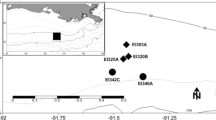Abstract
Free vehicles carrying bait, video cameras and current meters were deployed at three sites in the abyssal North Pacific Ocean in 1983 and 1984 (at depths of 3 800, 4 400 and 5 800 m). From the recovered video recordings, we analyzed responses of the abyssal grenadier fishes Coryphaenoides spp. to the bait, and, from the recovered current meters, we determined the velocities of the nearbottom tidal currents. The grenadiers consistently arrived at the camera within minutes after it landed (7.5 to 41 min, N=9 deployments), but the times of the first arrivals tended to increase within increasing distance from shore (which was correlated with increasing depth). Faster responses occurred near times of peak, as opposed to slack, current velocities. Behavioral observations suggest that grenadiers primarily use olfaction in locating the bait, because 75% of early arrivals came from down-current. Those coming from up-current typically did not appear to sense the bait until arriving down-current from it. A “wait” rather than “search” strategy is proposed for the use of food falls by these deep-sea scavengers.
Similar content being viewed by others
Literature cited
Batschelet, E.: Circular statistics in biology, 371 pp. London: Academic Press 1981
Cohen, D. M. and D. L. Pawson: Observations from the DSRV Alvin on populations of benthic fishes and selected larger invertebrates in and near DWD 106. In: Baseline report of environmental conditions in deepwater dumpsite 106, NOAA dumpsite evaluation report 77-1, Vol. 3. pp 423–450. Rockville, Maryland: U.S. Department of Commerce, NOAA National Ocean Survey 1977
Dayton, P. K. and R. R. Hessler: Role of biological disturbance in maintaining diversity in the deep-sea. Deep-Sea Res. 19, 199–208 (1972)
Guennegan, Y. and M. Rannou: Semi-diurnal rhythmic activity in deep-sea benthic fishes in the Bay of Biscay. Sarsia 64, 113–116 (1979)
Haedrich, R. L. and N. R. Henderson: Pelagic food of Coryphaenoides armatus, a deep benthic rattail. Deep-Sea Res. 21, 739–744 (1974)
Haedrich, R. L. and G. T. Rowe: Megafaunal biomass in the deep-sea. Nature, Lond. 269, 141–142 (1977)
Hamner, P. and W. M. Hamner: chemosensory tracking of scent trails by the planktonic shrimp Acetes sibogae australis. Science, N.Y. 195, 886–895 (1977)
Hessler, R. R., C. L. Ingram, A. A. Yayanos and B. R. Burnett: Scavenging amphipods from the floor of the Philippine trench. Deep-Sea Res. 25, 1029–1047 (1978)
Ingram, C. L. and R. R. Hessler: Distribution and behavior of scavenging amphipods from the central North Pacific. Deep-Sea Res. 30, 683–705 (1983)
Isaacs, J. D.: The nature of oceanic life. Scient. Am. 221, 146–162 (1969)
Isaacs, J. D., J. L. Reid, Jr., G. B. Shick and R. A. Schwartzlose: Near-bottom tidal currents measured in 4 kilometers depth off the Baja California coast. J. geophys. Res. 71, 4297–4301 (1966)
Isaacs, J. D. and R. A. Schwartzlose: Active animals of the deep-sea floor. Scient. Am. 233, 85–91 (1975)
Jumars, P. A. and E. D. Gallagher: Deep-sea community structure: three plays on the benthic proscenium. In: Environment of the deep-sea, pp 218–255. Ed. by W. G. Ernst and J. G. Morin. Englewood Cliffs: Prentice-Hall 1982
Lampitt, R. S. and M. P. Burnham: A free fall time lapse camera and current meter system “Bathysnap” with notes on the foraging behaviour of a bathyal decapod shrimp. Deep-Sea Res. 30, 1009–1017 (1983)
Lampitt, R. S., N. R. Merrett and M. H. Thurston: Inter-relations of necrophageous amphipods, a fish predator, and tidal currents in the deep sea. Mar. Biol. 74, 73–78 (1983)
Laver, M. B., M. S. Olsson, J. L. Edelman and K. L. Smith, Jr.: Swimming rates of scavenging deep-sea amphipods recorded with a free-vehicle video camera. (In preparation). (1984)
Pearcy, W. G. and J. W. Ambler: Food habits of deep-sea macrourid fishes of the Oregon coast. Deep-Sea Res. 21, 745–759 (1974)
Pearcy, W. G., D. L. Stein and R. S. Carney: The deep-sea benthic fish fauna of the northeastern Pacific Ocean on Cascadia and Tufts abyssal plains and adjoining continental slopes. Biol. Oceanogr. (NY.) 1, 375–427 (1982)
Sessions, M. H. and P. M. Marshall: A precision deep-sea time release. Scripps Instn Oceanogr. Ref. Ser. 71–5, 1–18 (1971). (Internal publication)
Smith, K. L., Jr. and R. J. Baldwin: Vertical distribution of the necrophagous amphipod, Eurythenes gryllus in the North Pacific: spatial and temporal variation. Deep-Sea Res. (In press) (1984)
Smith, K. L., Jr., M. B. Laver and N. O. Brown: Sediment community oxygen consumption and nutrient exchange in the central and eastern North Pacific. Limnol. Oceanogr. 28, 882–898 (1983)
Smith, K. L., Jr., G. A. White, M. B. Laver, R. R. McConnaughy and J. P. Meador: Free vehicle capture of abyssopelagic animals. Deep-Sea Res. 26, 57–64 (1979)
Stockton, W. L. and T. E. DeLaca: Food falls in the deep-sea: occurrence, quality, and significance. Deep-Sea Res. 29, 157–169 (1982)
Taft, B. A., R. S. Ramp, J. G. Dworski and G. Holloway: Measurements of deep-currents in the central North Pacific. J. geophys. Res. 86, 1955–1968 (1981)
Thurston, M. H.: Scavenging abyssal amphipods from the North-East Atlantic Ocean. Mar. Biol. 51, 55–68 (1979)
Wilson, R. R., Jr. and R. S. Waples: Distribution, morphology, and biochemical genetics of Coryphaenoides armatus and C. yaquinae (Pisces: Macrouridae) in the central and eastern North Pacific. Deep-Sea Res. 30, 1127–1145 (1983)
Wilson, R. R., Jr. and R. S. Waples: Electrophoretic and biometric variability in the abyssal grenadier Coryphaenoides armatus of the western North Atlantic, eastern South Pacific and eastern North Pacific Oceans. Mar. Biol. 80, 227–237 (1984)
Wimbush, M. and W. Munk: The benthic boundary laver. In: The sea, Vol. 4 pp 732–758. Ed. by A. E. Maxwell. New York: Wiley & Sons 1970
Author information
Authors and Affiliations
Additional information
Communicated by N. D. Holland, La Jolla
Rights and permissions
About this article
Cite this article
Wilson, R.R., Smith, K.L. Effect of near-bottom currents on detection of bait by the abyssal grenadier fishes Coryphaenoides spp., recorded in situ with a video camera on a free vehicle. Mar. Biol. 84, 83–91 (1984). https://doi.org/10.1007/BF00394530
Accepted:
Issue Date:
DOI: https://doi.org/10.1007/BF00394530




